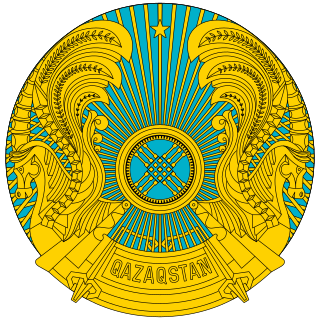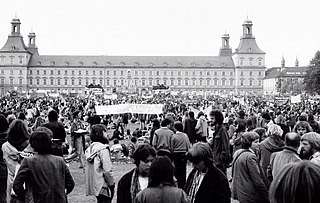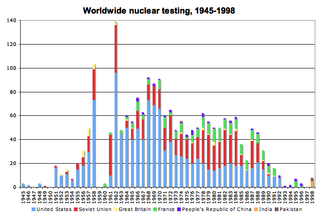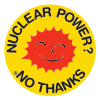
Foreign relations of Kazakhstan are primarily based on economic and political security. The Nazarbayev administration has tried to balance relations with Russia and the United States by sending petroleum and natural gas to its northern neighbor at artificially low prices while assisting the U.S. in the War on Terror. Kazakhstan is a member of the United Nations, Organization for Security and Co-operation in Europe, North Atlantic Cooperation Council, Commonwealth of Independent States, the Shanghai Cooperation Organisation, and NATO's Partnership for Peace program. Kazakhstan established a customs union with Russia and Belarus, transformed into the Eurasian Economical Community then in 2015 into the Eurasian Economic Union. President Nazarbayev has prioritized economic diplomacy into Kazakhstan's foreign policy.

Nuclear disarmament is the act of reducing or eliminating nuclear weapons. It can also be the end state of a nuclear-weapons-free world, in which nuclear weapons are completely eliminated. The term denuclearization is also used to describe the process leading to complete nuclear disarmament.

Nuclear weapons tests are experiments carried out to determine nuclear weapons' effectiveness, yield, and explosive capability. Testing nuclear weapons offers practical information about how the weapons function, how detonations are affected by different conditions, and how personnel, structures, and equipment are affected when subjected to nuclear explosions. However, nuclear testing has often been used as an indicator of scientific and military strength. Many tests have been overtly political in their intention; most nuclear weapons states publicly declared their nuclear status through a nuclear test.

The Pugwash Conferences on Science and World Affairs is an international organization that brings together scholars and public figures to work toward reducing the danger of armed conflict and to seek solutions to global security threats. It was founded in 1957 by Joseph Rotblat and Bertrand Russell in Pugwash, Nova Scotia, Canada, following the release of the Russell–Einstein Manifesto in 1955.

Semey, until 2007 known as Semipalatinsk and in 1917–1920 as Alash-qala, is a city in eastern Kazakhstan, in the Kazakh part of Siberia. When Abai Region was created in 2022, Semey became its administrative centre. It lies along the Irtysh River near the border with Russia, 1,000 kilometers (620 mi) north of Almaty and 700 kilometers (430 mi) southeast of the Russian city of Omsk. Its population is 299,264.

The Semipalatinsk Test Site, also known as "The Polygon", was the primary testing venue for the Soviet Union's nuclear weapons. It is located on the steppe in northeast Kazakhstan, south of the valley of the Irtysh River. The scientific buildings for the test site were located around 150 km (93 mi) west of the town of Semipalatinsk, near the border of East Kazakhstan Region and Pavlodar Region with most of the nuclear tests taking place at various sites further to the west and south, some as far as into Karagandy Region.

The anti-nuclear movement is a social movement that opposes various nuclear technologies. Some direct action groups, environmental movements, and professional organisations have identified themselves with the movement at the local, national, or international level. Major anti-nuclear groups include Campaign for Nuclear Disarmament, Friends of the Earth, Greenpeace, International Physicians for the Prevention of Nuclear War, Peace Action and the Nuclear Information and Resource Service. The initial objective of the movement was nuclear disarmament, though since the late 1960s opposition has included the use of nuclear power. Many anti-nuclear groups oppose both nuclear power and nuclear weapons. The formation of green parties in the 1970s and 1980s was often a direct result of anti-nuclear politics.

Olzhas Omaruly Suleimenov is a Kazakh former Soviet dissident, Russian-language poet, Turkologist, politician, and anti-nuclear activist.

Corbin Harney was an elder and spiritual leader of the Newe people. Harney reportedly inspired the creation in 1994 of the Shundahai Network, which works for environmental justice and nuclear disarmament. The Shundahai Network plays a key role in organizing non-violent civil disobedience aimed at bringing about the closure of the Nevada Test Site, used for testing nuclear weapons, which is located on Western Shoshone land.

The anti-nuclear movement in the United States consists of more than 80 anti-nuclear groups that oppose nuclear power, nuclear weapons, and/or uranium mining. These have included the Abalone Alliance, Clamshell Alliance, Committee for Nuclear Responsibility, Nevada Desert Experience, Nuclear Information and Resource Service, Physicians for Social Responsibility, Plowshares Movement, Women Strike for Peace, and Women's International League for Peace and Freedom. The anti-nuclear movement has delayed construction or halted commitments to build some new nuclear plants, and has pressured the Nuclear Regulatory Commission to enforce and strengthen the safety regulations for nuclear power plants.
Anti-nuclear organizations may oppose uranium mining, nuclear power, and/or nuclear weapons. Anti-nuclear groups have undertaken public protests and acts of civil disobedience which have included occupations of nuclear plant sites. Some of the most influential groups in the anti-nuclear movement have had members who were elite scientists, including several Nobel Laureates and many nuclear physicists.

Anti-nuclear protests began on a small scale in the U.S. as early as 1946 in response to Operation Crossroads. Large scale anti-nuclear protests first emerged in the mid-1950s in Japan in the wake of the March 1954 Lucky Dragon Incident. August 1955 saw the first meeting of the World Conference against Atomic and Hydrogen Bombs, which had around 3,000 participants from Japan and other nations. Protests began in Britain in the late 1950s and early 1960s. In the United Kingdom, the first Aldermaston March, organised by the Campaign for Nuclear Disarmament, took place in 1958. In 1961, at the height of the Cold War, about 50,000 women brought together by Women Strike for Peace marched in 60 cities in the United States to demonstrate against nuclear weapons. In 1964, Peace Marches in several Australian capital cities featured "Ban the Bomb" placards.

The application of nuclear technology, both as a source of energy and as an instrument of war, has been controversial.

These are lists of nuclear disasters and radioactive incidents.
Keshrim Boztayev is a Kazakh political activist working to attain health care for those affected by the Soviet nuclear test program.

The International Day against Nuclear Tests is observed on August 29. It was established on December 2, 2009, at the 64th session of the United Nations General Assembly by the resolution 64/35, which was adopted unanimously.
The ATOM Project is an international campaign by the Nazarbayev Center of Kazakhstan. The primary goal of the campaign is to build international support for the abolishment of nuclear testing. ATOM stands for "Abolish Testing. Our Mission." The goal is to achieve in force the Comprehensive Nuclear Test Ban Treaty through online petitions and other methods.
The Shagan is a river in the east of Kazakhstan and a left-bank tributary of the Irtysh. It is not to be confused with the Shagan in the west of Kazakhstan, which is a tributary of the Ural. The river is 275 km long.

The Republic of Kazakhstan became a member of the United Nations on March 2, 1992. Kazakhstan was elected to serve on the UN Security Council for the 2017–2018 term. UN Secretary-General António Guterres in remarks to the UNSC recognized Kazakhstan's work to rid the world of weapons of mass destruction and global non-proliferation efforts.

The collapse of the Soviet Union made Kazakhstan, the fourth-largest nuclear power in the world, leading to its rapid denuclearization. Formally known as the Kazakh Autonomous Soviet Socialist Republic, the former republic had a considerably large nuclear infrastructure due to its reliance on civilian nuclear programs as a means to develop its economy. The nuclear infrastructure and economy of Kazakhstan heavily depended on the cooperation between their country and Russia since its inception as an independent country.

















